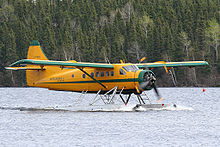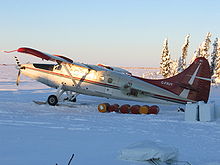- de Havilland Canada DHC-3 Otter
-
DHC-3 Otter Turbine Otter in Harbour Air livery Role STOL utility transport Manufacturer de Havilland Canada First flight 12 December 1951 Introduction 1953 Status Active Produced 1951-1967 Number built 466 Developed into DHC-6 Twin Otter The de Havilland Canada DHC-3 Otter is a single-engined, high-wing, propeller-driven, STOL aircraft developed by de Havilland Canada. It was conceived to be capable of performing the same roles as the earlier and highly successful Beaver, but was overall a larger aircraft.
Contents
Design and development
When de Havilland Canada began design work on the "King Beaver" (the Otter's original name) in January 1951, it was trying to extend the company's line of rugged STOL utility transports that had begun with the Beaver. The single-engined, high-wing, propeller-driven DHC-3 Otter was conceived to be capable of performing the same roles as the Beaver, but was considerably larger, the veritable "one-ton truck" (in company parlance, the Beaver was the "half-ton truck").[1]
Using the same overall configuration of the earlier and highly successful DHC2 Beaver, the new design incorporated a longer fuselage, greater-span wings, and was much heavier. Seating in the main cabin is for 10 or 11, whereas the Beaver could seat six. Power is supplied by a 450-kW (600 hp) Pratt & Whitney Wasp radial. Like the Beaver, the Otter can be fitted with skis or floats. The Otter served as the basis for the very successful Twin Otter, which featured two wing-mounted Pratt & Whitney Canada PT6 turboprops.
The Otter received Canadian certification in November 1952 and entered production shortly after.
Operational use
The DHC-3/CSR-123 Otter was used until 1980 by the Royal Canadian Air Force and its successor, the Air Command of the Canadian Forces. It was used in Search and Rescue, as the "CSR" denotes Canadian Search (and) Rescue (type 123). The engine is a Pratt & Whitney R-1340 (1,340 cubic inches) geared engine. The version used in the Otter was geared for lower prop revs and consequently lower airspeed. The electrics were 28 volts D.C. It was also operated on EDO floats on water and skis for winter operations on snow. The EDO floats also had wheels for use on runways (amphibious). It was used as army support dropping supplies on parachutes, and also non-parachute low-speed, low-altitude air drops, to support the Canadian Army on maneuvers. In the end it was operated by the Primary Air Reserve in Montreal, Toronto and Winnipeg, with approximately 10 aircraft at each base, as well as by the RSU (Regular (Forces) Support Units) at those bases. It was usually flown with a single pilot (Commissioned Officer) in the left seat and a Technical Air Crewman (NCO) in the right seat. It was stood down, and the Kiowa helicopter replaced it in Air Reserve squadrons.
Although the Otter found ready acceptance in bush airlines, as in a similar scenario to the DHC-2 Beaver, the United States Army soon became the largest operator of the aircraft (184 delivered as the U-1A Otter). Other military users included Australia, Canada, and India, but the primary role of the aircraft as a rugged bush plane continues to this day.
An Otter crossed the South Pole in 1957 (see Commonwealth Trans-Antarctic Expedition). The Otter is also popular in the skydiving community and can be found in many dropzones throughout the world.
Modifications
Some aircraft were converted to turbine power using a PT6A, Walter 601 (manufactured in the Czech Republic), or Garrett/Honeywell TPE331-10, by Texas Turbine Conversions. A Polish Pezetel radial engine has also been fitted. Re-engined aircraft have been offered since the 1980s by Airtech Canada as the DHC-3/1000 using current-production 1,000 hp (745 kW) PZL ASz-62 IR radials.[2]
Variants
- DHC-3 Otter : Single-engined STOL utility transport aircraft.
- CSR-123 Otter : STOL utility transport aircraft for the Royal Canadian Air Force.
- YU-1 Otter : Six test and evaluation aircraft for the U.S. Army.
- U-1A Otter : STOL utility transport aircraft for the US Army.
- UC-1 Otter : STOL utility transport aircraft for the United States Navy. Later redesignated U-1B Otter in 1962.
- DHC-3-T Turbo-Otter : Otter fitted with either a PT6A-27 or PT6A-34 turboprop engine.
Military operators
- Royal Australian Air Force - Two Otters (RAAF serial A100-1 and 2) were in service with the RAAF from 1961 to 1967. The aircraft were used for passenger and freight transport duties at the Weapons Research Establishment, Woomera, South Australia.
- No. 1 Air Trials Unit
- Burma Air Force
- Royal Cambodian Air Force - Former operator.
- Paraguayan Air Force 1 DHC-3 donated by Argentina.
Accidents
On 9 August 2010, a DHC-3T registered to Anchorage-based GCI crashed about 17 miles (27 km) north of Dillingham, Alaska, while en route to a private fishing lodge.[3] Five of the nine people on board were killed, including former Alaska Senator Ted Stevens. Surviving passengers included former NASA administrator Sean O'Keefe and his teenage son, both of whom sustained injuries.[4]
Specifications (Landplane)
Data from Jane's Civil and Military Aircraft Upgrades 1994-95[5]
General characteristics
- Crew: 1
- Capacity: 9 -10 passengers
- Length: 41 ft 10 in (12.80 m)
- Wingspan: 58 ft 0 in (17.69 m)
- Height: 12 ft 7 in (3.83 m)
- Wing area: 375 sq ft (34.84 m²)
- Empty weight: 4,431 lb (2,010 kg)
- Max takeoff weight: 8,000 lb (3,629 kg)
- Powerplant: 1 × Pratt & Whitney R-1340-S1H1-G Wasp 9-cylinder air-cooled radial engine, 600 hp (448 kW)
Performance
- Maximum speed: 160 mph (139 knots, 257 km/h)
- Cruise speed: 121 mph (105 knots, 195 km/h) at sea level (econ cruise)
- Stall speed: 58 mph (50 knots, 93 km/h)
- Range: 945 mi (822 nmi, 1,520 km)
- Service ceiling: 18,800 ft (5,730 m)
- Rate of climb: 850 ft/min (4.3 m/s)
See also
- Related development
- Aircraft of comparable role, configuration and era
- Cessna Caravan
- Quest Kodiak
- PAC 750XL
- Pilatus PC-6
- Sherpa K650T
- Antonov An-2
- Related lists
References
- Notes
- ^ Rossiter 1998, p. 55.
- ^ Taylor 1988 p. 17.
- ^ Trimble, Stephen. "EADS executive survives Alaska air crash, but former senator killed." flightglobal.com, 10 August 2010. Retrieved: 10 August 2010.
- ^ Bohrer, Becky. "Plane crashes in Alaska kills former Alaska Sen. Ted Stevens, ex-NASA chief survives." The Associated Press. via 680news.com, 10 August 2010. Retrieved: 10 August 2010.
- ^ Michell 1994, p.24.
- Bibliography
- Hayes, Karl E. DHC-3 Otter - A History (CD-ROM). Crakaig, Killiney Hill Road, Killiney, Co. Dublin, Ireland: Karl E. Hayes Publisher, 2006. (also available via CANAV Books, Toronto)
- Hotson, Fred W. The de Havilland Canada Story. Toronto: CANAV Books, 1983. ISBN 0-07-549483-3.
- Michell, Simon. (ed.). Jane's Civil and Military Aircraft Upgrades 1994-95. Coulsdon, UK: Jane's Information Group, 1994. ISBN 0-7106-1208-7.
- Milberry, Larry. Aviation In Canada. Toronto: McGraw-Hill Ryerson Ltd., 1979. ISBN 0-07-082778-8.
- Molson, Ken M. and Harold A. Taylor. Canadian Aircraft Since 1909. Stittsville, Ontario: Canada's Wings, Inc., 1982. ISBN 0-920002-11-0.
- Rossiter, Sean. The Immortal Beaver: The World's Greatest Bush Plane. Vancouver: Douglas & McIntyre, 1999. ISBN 1-55054-724-0.
- Rossiter, Sean. Otter & Twin Otter: The Universal Airplanes. Vancouver: Douglas & McIntyre, 1998. ISBN 1-55054-637-6.
- Taylor, John W.R., ed. Jane's All The World's Aircraft 1988-89. Coulsdon, UK: Jane's Defence Data, 1988. ISBN 0-7106-0867-5.
External links
- de Havilland Canada DHC-3 CC-123 Otter
- De Havilland Canada D.H.C.3 'Otter'
- US Navy Otter service in Antarctica
de Havilland Canada aircraft DHC-1 · DHC-2 · DHC-3 · DHC-4 · DHC-5 · DHC-6 · DHC-7 · DHC-8
CS2F Tracker · Gipsy Moth · Tiger Moth · Fox Moth · Mosquito
Canadian Forces unified aircraft designations post-1968 100-125 126–150 151- USN/USMC utility aircraft designations 1955–1962 de Havilland Canada UC • (U2C not actually used)
Grumman Piper Lockheed United States tri-service utility aircraft designations post-1962 Lists relating to aviation General Aircraft (manufacturers) · Aircraft engines (manufacturers) · Airlines (defunct) · Airports · Civil authorities · Museums · Registration prefixes · Rotorcraft (manufacturers) · TimelineMilitary Accidents/incidents Records Categories:- Canadian civil utility aircraft 1960–1969
- Canadian military utility aircraft 1960–1969
- Seaplanes and flying boats
- De Havilland Canada aircraft
- DHC-3 Otter : Single-engined STOL utility transport aircraft.
Wikimedia Foundation. 2010.






